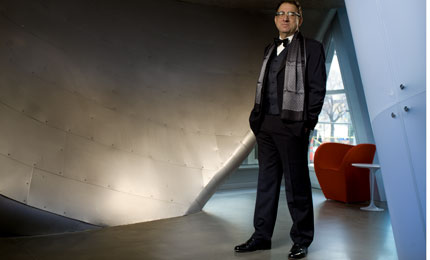Do you have particular designers that you go to for that?
Sometimes. I like Paul Smith, and Hugo Boss has some great stuff, absolutely. But I don’t seek out a designer so much as try to take it all in.
The Look: Vintage coat by Felshire Tailors, 1955; Ted Baker Hat, Versace scarf, Haband tie from Derks Formals; Sean Jean suit from Macy’s; Bracelet from Crowley’s Jewellers and Goldsmiths
That’s interesting because when buying vintage clothing, it’s almost as much about the experience of looking for things as it is about wearing the clothes.
Oh, yes, it’s all part of it. Although I can get into ruts where I’m always going for the same thing. I’ve really got a thing for Bostonian shoes because I think they’re such a standard that you can really play with it.
You’ve only mentioned suits, but do you ever dress down? What do you wear to the antique malls?
I may not wear a tie, but I might still wear a suit. I feel very comfortable wearing a suit. I basically don’t have a weekend wardrobe. I might wear jeans and a suit jacket or sports coat.
What’s your favourite thing to put on?
Coats. I have quite a collection. I’m always open to a really great overcoat.
Did that influence your decision to come to a cold Prairie town?
It does give me an excuse to wear them an awful lot.
Favourites
Museum: Tate Modern in London, Guggenheim in New York
Alcoholic drink: Scotch in the winter, vodka in the summer
Comfort Food: When I’m good, yogurt; when I’m bad, peanut butter
Celebrity chef: Nigella Lawson
TV show: CBC’s The National
Movie: Sweet Smell of Success
Getaway: Our Lake Winnipeg cottage
Car: BMW 6 Series
Luxury: A great hotel
